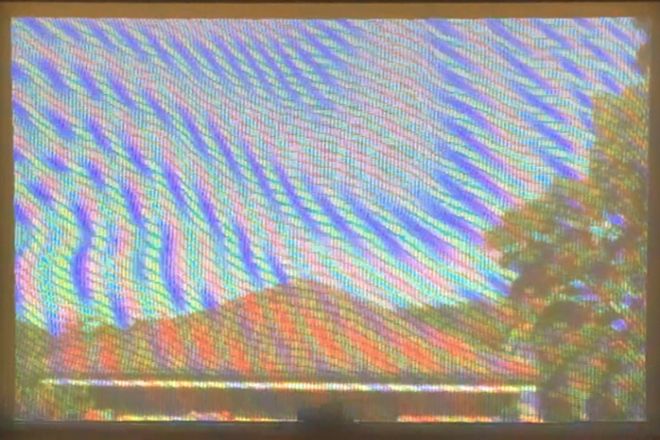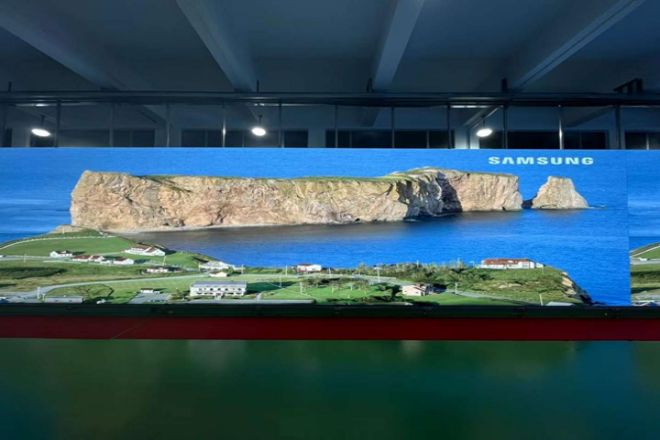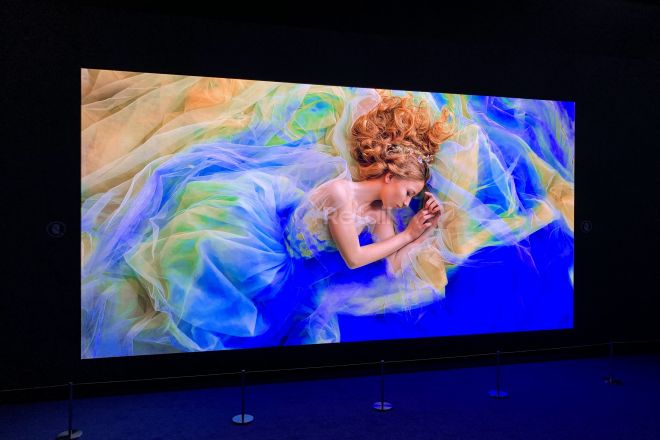Introduction

Under the wave of digitalization and informatization, LED display screens, as an outstanding representative of modern display technology, have been widely used in many fields such as indoor and outdoor advertising, conference display, stage performances, sports events, etc. with their advantages of high brightness, wide color gamut, and long life.
However, with the continuous expansion of applications and users’ pursuit of display effects, the resolution problem of LED display screens has gradually become prominent, and the closely related moiré phenomenon has become an important factor affecting the display effect.
1. Overview of LED display screen resolution
The resolution of an LED display screen refers to the density of its pixels, that is, the number of pixels in the horizontal and vertical directions on the display screen, usually expressed as “horizontal pixels × vertical pixels.”
For example, a resolution of 1920×1080 means that the display screen has 1920 pixels in the horizontal direction and 1080 pixels in the vertical direction.
1). Describe the relationship between pixel density and resolution
Pixel density (Pixel Density) refers to the number of pixels per unit area (such as per square meter or per inch), usually expressed in PPI (Pixels Per Inch). The higher the pixel density, the more pixels there are in the same area, so the display has richer details and clearer images.
Resolution is closely related to pixel density. On a display screen of the same size, the higher the resolution, the higher the pixel density, and vice versa.
2). Impact of resolution on display effect
Resolution has a decisive influence on the display effect of LED display screens. The higher the resolution, the richer the image details that the display screen can display and the higher the image quality.
High-resolution LED display screens can present more delicate and realistic images, especially when viewed at close range; users can feel clearer picture quality.
3). Classification and standards of resolution
Definition of high resolution, standard resolution, and low resolution:
High resolution:
Such as 4K (3840×2160 pixels) or higher resolution, usually used in occasions requiring extremely high image quality, such as professional display equipment, high-end TVs, etc.
Standard resolution, such as 1080p (1920×1080 pixels), is currently the most common resolution standard, suitable for most TVs, computer monitors, and multimedia devices.
Low resolution:
Such as 720p (1280×720 pixels) and below, usually used for smaller display screens or specific applications.
4). Resolution requirements in different application scenarios:
Outdoor billboards or large event sites: Since the audience is far away, the resolution requirements are relatively low.
Indoor venues such as conference rooms or exhibitions: Since the audience is close, the resolution requirements are higher.
5). Technical approaches to improve resolution
Micro LED technology: By using smaller LED chips, more pixels can be integrated into the same area, thereby improving resolution.
Dot pitch reduction technology: By reducing the spacing between pixels, the resolution can be improved without changing the size of the display.
Drive circuit optimization: Optimizing the design and algorithm of the drive circuit can increase the refresh rate and grayscale level of the display, thereby improving the display effect and resolution.
2 . Analysis of moiré phenomenon

1). Definition and cause of moiré
Moiré pattern, also known as interference fringes, is a regular interference effect formed by two or more overlapping objects. When light passes through the surface of an object, due to the slight changes in the wavelength of light and the surface of the object, cross ripples, i.e., moiré, are generated.
2). The physical principle of moiré generation
The generation of moiré is mainly due to the interference between two periodic structures (such as the pixel arrangement of the LED display and the perception of the camera or the eye). When two light waves meet, they will overlap to form light and dark interference fringes.
3). The impact of moiré on image quality
The appearance of moiré is usually manifested as repeated patterns or ripples on the display, which will reduce the clarity and quality of the image and affect the viewing experience.
4). The relationship between moiré and LED display
- Moiré problem caused by insufficient resolution
When the resolution of the LED display is low, the distance between the pixels is large, which is easy to overlap periodically with the perception structure of the camera or the eye, thereby causing the moiré phenomenon.
- The relationship between pixel arrangement and moiré
The pixel arrangement of the LED display will also affect the generation of moiré. Different pixel arrangements may lead to different interference effects, which in turn affect the display effect of the image.
3. Discussion on the relationship between the resolution and moiré of LED display
1). Analysis of the impact of resolution on moiré
- The inhibitory effect of high resolution on moiré
When the resolution of the LED display is high enough, the distance between the pixels will become smaller, which will weaken the interference effect between the pixel arrangement and the perception structure of the camera or the eye, thereby reducing the generation of moiré.
High-resolution display screens can present more delicate and clear images, reduce the obvious boundaries between pixels, and thus effectively suppress the appearance of moiré.
- The generation and aggravation of moiré when the resolution is insufficient
On the contrary, when the resolution of the LED display screen is low, the distance between the pixels is large, which easily overlaps periodically with the perception structure of the camera or the eye, thus causing the moiré phenomenon.
In addition, when the pixel arrangement of the display screen is close to the perception structure of the camera or the eye, the moiré problem may be more serious.
2). Practical application case analysis
- The advantages of high-resolution LED display screens in reducing moiré
In high-end display devices, such as 4K or higher resolution LED display screens, due to their high pixel density and delicate images, they can significantly reduce the generation of moiré. This type of display screen has a wide range of applications in photography, film and television production, advertising display, and other fields, and can provide clearer and more realistic visual effects.
- Treatment strategies for moiré problems in low-resolution display screens
For LED display screens with low resolution, in order to reduce the impact of moiré, some treatment strategies can be adopted, for example, by optimizing the pixel arrangement design and using image processing algorithms to reduce the moiré phenomenon. In addition, changing the angle and position of the camera or observer, adjusting the focus setting, etc., can alleviate the moiré problem to a certain extent.
3). Future development trend forecast
- Continuous development of resolution enhancement technology
With the advancement and innovation of technology, the resolution of LED displays will continue to increase. The development of technologies such as micro-LED technology, dot pitch reduction technology, and drive circuit optimization will drive the image quality of LED displays to a higher level. This will help further reduce the generation of moiré and improve the display effect.
- Innovation and application of moiré elimination technology
In order to solve the moiré problem, future research will focus on the innovation and application of moiré elimination technology. By developing more advanced image processing algorithms and hardware anti-moiré technology, the probability of moiré occurrence can be effectively reduced, and the display effect can be improved.
In addition, with the development of intelligent and interconnected technologies, LED displays will be more intelligent and can automatically adjust the display effect according to environmental changes and usage scenarios, further reducing the occurrence of interference factors such as moiré.
4. How to effectively eliminate moiré?

To effectively eliminate moiré, the following methods can be used:
Change the camera angle: Since the angle between the camera and the object will cause moiré, slightly changing the angle of the camera (by rotating the camera) can eliminate or change any moiré that exists.
Change the camera position: Changing the angle relationship by moving left and right or up and down can reduce moiré.
Change the focus: Too sharp focus and high detail on fine patterns may cause moiré. Slightly changing the focus can change the clarity and help eliminate moiré.
Change the focal length of the lens: Using different lenses or focal length settings can change or eliminate moiré.
Use a front filter: Install it directly in front of the CCD so that its exposure conditions meet the spatial frequency, thoroughly filter the high spatial frequency part of the image, and reduce the chance of moiré. But please note that this will also reduce the sharpness of the image at the same time.
Software processing: Image processing software such as Photoshop plug-ins are used to eliminate any moiré that appears on the final image.
Optimize pixel arrangement design: By improving the pixel arrangement design of the LED display, the periodic overlap between pixels can be reduced, thereby reducing the generation of moiré.
Camera pixel bias technology: This method maximizes the brightness level resolution of the CCD camera but may not completely eliminate moiré because the image sensor still has a certain spatial frequency.
Optical processing: With an optically processed LED display, the camera can capture images without moiré at various angles, positions, and focal lengths.
Choose high-quality materials: For the LED display itself, choosing high-quality materials can reduce the roughness of the screen surface, thereby reducing the number of light reflections and interferences and reducing the generation of moiré.
It should be noted that the effectiveness of these methods may be affected by the specific use environment and equipment, and different methods may be more effective in different application scenarios. In actual operation, it may be necessary to combine multiple methods to achieve the best effect of eliminating moiré.
In addition, the feasibility and efficiency of actual operation may also need to be considered for TV cameras, especially for specific occasions such as live TV programs. In these cases, more professional equipment and software may be needed to deal with moiré problems.
Conclusion
In summary, there is a close relationship between the resolution of LED display and moiré. By deeply understanding these two concepts and taking effective technical means to optimize the display effect, we can better meet users’ needs for high-quality displays.
Finally, if you want to know more about LED displays, please get in touch with us.
